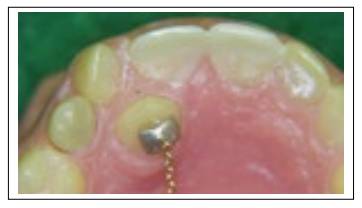Exposure of Impacted Upper Canine
Please note, this page is printable by selecting the normal print options on your computer.
This leaflet has been designed to improve your understanding of any forthcoming treatment and contains answers to many commonly asked questions. If you have any other questions that
the leaflet does not answer or would like further explanation please ask.
The Problem
The canine, or eye tooth, normally erupts into the mouth between the ages of 11 and 13. Sometimes one or both canines develop in the wrong position. Often they lie across the roof of the mouth behind the front teeth.

Why do I need treatment?
Because one or other of your canines are in the wrong place. As part of your on-going orthodontic (braces) treatment, it is necessary to help the tooth erupt into the mouth. If left alone, the tooth will not erupt normally and may either damage the roots of the other teeth or push them out of position.
What does the treatment involve?
Helping the tooth erupt into your mouth involves a relatively minor surgical procedure. This usually takes place under day case general anaesthesia. Although you are put to sleep completely you will be able to go home on the same day as surgery. While you are asleep the gum lying over the canine will be pushed back. Occasionally some of the bone around the crown of the tooth also needs to be removed to uncover the tooth.
How will the Orthodontist pull the tooth into the correct position?
Once the canine is exposed one of three things will happen under the same anaesthetic. What is going to happen for you will already have been discussed.
• Bracket and Chain
A small bracket is glued to the tooth. Attached to this is a chain which your orthodontist can then use to pull the tooth into the right position. The chain is usually stitched out of the way but it is quite delicate and therefore it is important to be careful when eating for the first few weeks after surgery.

• A Plate
Sometimes a small window will be cut in the gum over the tooth and a plastic “dressing” plate put in place to cover the area. This plate is held in your mouth with clips that attach to some of your back teeth. It is important that you wear the plate all the time except when you take it out to clean your teeth. Without the plate the gum may grow back making it difficult for the orthodontist to move the tooth into position.
• A Pack
Sometimes a pack called ‘Coepak’ (a putty like material) is placed over the tooth after it is exposed. The pack is kept in position with stitches and removed after a few weeks. You must be careful not to dislodge the pack. If this happens you should contact the department for advice. Sometimes it is necessary to hold the gum back in the right position with stitches at the end of the operation. These are usually dissolvable and take about two weeks to disappear.
Is there much pain or swelling?
All of the above procedures are not particularly painful but you will obviously experience some soreness afterwards. There is usually very little in the way of swelling. If it is likely to be sore your surgeon will arrange painkillers for you. It is not necessary to take antibiotics.
Will I need another appointment?
You will need to return a few weeks after your surgery to have the area checked by your orthodontist or surgeon. Further appointments after this will obviously be necessary for your on-going orthodontic care.
Oral Maxillo & Facial Surgery, Main Outpatients, Milton Keynes Hospital, 01908 995308.
